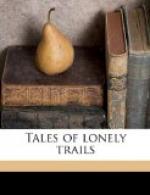“Come, saddle up,” called the never restful Jones. “Leave the Indian in camp with the hounds, and we’ll get the lay of the land.” All afternoon we spent riding the plateau. What a wonderful place! We were completely bewildered with its physical properties, and surprised at the abundance of wild horses and mustangs, deer, coyotes, foxes, grouse and other birds, and overjoyed to find innumerable lion trails. When we returned to camp I drew a rough map, which Jones laid flat on the ground as he called us around him.
“Now, boys, let’s get our heads together.”
In shape the plateau resembled the ace of clubs. The center and side wings were high and well wooded with heavy pines; the middle wing was longest, sloped west, had no pine, but a dense growth of cedar. Numerous ridges and canyons cut up this central wing. Middle Canyon, the longest and deepest, bisected the plateau, headed near camp, and ran parallel with two smaller ones, which we named Right and Left Canyons. These three were lion runways and hundreds of deer carcasses lined the thickets. North Hollow was the only depression, as well as runway, on the northwest rim. West Point formed the extreme western cape of the plateau. To the left of West Point was a deep cut-in of the rim wall, called the Bay. The three important canyons opened into it. From the Bay, the south rim was regular and impassable all the way round to the narrow Saddle, which connected it to the mainland.
“Now then,” said Jones, when we assured him that we were pretty well informed as to the important features, “you can readily see our advantage. The plateau is about nine or ten miles long, and six wide at its widest. We can’t get lost, at least for long. We know where lions can go over the rim and we’ll head them off, make short cut chases, something new in lion hunting. We are positive the lions can not get over the second wall, except where we came up, at the Saddle. In regard to lion signs, I’m doubtful of the evidence of my own eyes. This is virgin ground. No white man or Indian has ever hunted lions here. We have stumbled on a lion home, the breeding place of hundreds of lions that infest the north rim of the canyon.”
The old plainsman struck a big fist into the palm of his hand, a rare action with him. Jim lifted his broad hat and ran his fingers through his white hair. In Emett’s clear desert-eagle eyes shown a furtive, anxious look, which yet could not overshadow the smouldering fire.
“If only we don’t kill the horses!” he said.
More than anything else that remark from such a man thrilled me with its subtle suggestion. He loved those beautiful horses. What wild rides he saw in his mind’s eye! In cold calculation we perceived the wonderful possibilities never before experienced by hunters, and as the wild spell clutched us my last bar of restraint let down.
During supper we talked incessantly, and afterward around the camp-fire. Twilight fell with the dark shadows sweeping under the silent pines; the night wind rose and began its moan.




